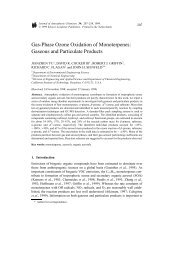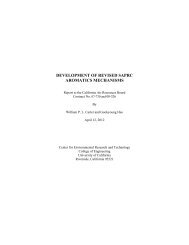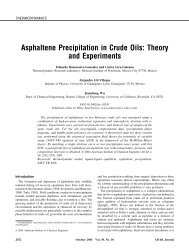Density functional theory for chemical engineering: From capillarity ...
Density functional theory for chemical engineering: From capillarity ...
Density functional theory for chemical engineering: From capillarity ...
You also want an ePaper? Increase the reach of your titles
YUMPU automatically turns print PDFs into web optimized ePapers that Google loves.
is applicable to dilute and semidilute polymer solutions as well<br />
as to polymer melts, polymers of essentially arbitrary architecture,<br />
and adsorbing or nonadsorbing polymers. 190<br />
The distribution of polymers near a colloidal particle and<br />
polymer-mediated colloidal <strong>for</strong>ces are significantly influenced<br />
by the particle–polymer interaction energy and by the size<br />
ratio. 191 In the absence of strong particle–polymer attraction,<br />
polymers in a good solvent are depleted from the surface of a<br />
large particle on the length scale comparable to the polymer<br />
radius of gyration. In this case, the colloidal <strong>for</strong>ce is predominantly<br />
attractive, as predicted qualitatively by the Asakura–<br />
Oosawa <strong>theory</strong>. The entropy-induced attractive potential increases<br />
with polymer concentration. When the polymer<br />
concentration is beyond a certain limit, however, the selfexclusion<br />
of polymer segments diminishes the depletion zone<br />
near the colloidal surface. Competition of surface depletion<br />
with excluded-volume effects induces a repulsive barrier in the<br />
solvation potential be<strong>for</strong>e the colloidal particles fall into deep<br />
attraction near contact. 192 Such repulsion could lead to restabilization<br />
of a polymer-flocculated colloidal dispersion that<br />
cannot be captured by Asakura–Oosawa <strong>theory</strong>. 96<br />
Upon addition of strong attraction between colloidal particles<br />
and polymer segments, the depletion layer disappears and<br />
accumulation of polymer chains near the particle surface leads<br />
to a colloidal repulsion. By contrast, more attraction between<br />
polymer segments upon changing solvent quality or temperature<br />
leads to stronger surface depletion and consequent colloidal<br />
aggregation. When the colloidal particle is significantly<br />
smaller than the polymer radius of gyration, the distribution of<br />
polymer segments near the particle surface is determined by the<br />
segment–particle interactions and by the polymer intramolecular<br />
correlations. For polymers in a good solvent, recent neutron-scattering<br />
experiments suggest that the excluded-volume<br />
effects between the polymer segments and the colloidal particles<br />
may cause the polymer chains to shrink or collapse significantly.<br />
193 As revealed by Monte Carlo simulations, 194,195 the<br />
reduction of polymer size can be explained by polymer wrapping<br />
around the colloidal particle. In this case, the potential of<br />
mean <strong>for</strong>ce between colloidal particles is also attractive. However,<br />
this attraction is not introduced by the depletion of<br />
polymer chains but probably arises from the excluded-volume<br />
effect of polymer segments and the intrachain correlations. The<br />
cause of attraction is reflected in the range of colloidal <strong>for</strong>ces<br />
that are normally much smaller than the polymer size. At a low<br />
polymer concentration, the polymer-mediated potential is very<br />
weak (0.05k B T) but is relatively long-range. Beyond the<br />
polymer overlap concentration, the segment-excluded volume<br />
becomes more significant and the short-range attraction is<br />
considerably enhanced. 196 For small colloids dissolved in a<br />
solution of nonadsorbing polymers, recent Monte Carlo simulation<br />
also indicates the colloidal <strong>for</strong>ce may exhibit long-range<br />
oscillation persisting over several multiples of the polymer<br />
radius of gyration. 197 Although a full capture of all the details<br />
of polymer-mediated colloidal <strong>for</strong>ces represents a significant<br />
theoretical challenge, application of DFT to polymer–colloid<br />
mixtures is certainly very promising.<br />
It has been long recognized that attachment of highly soluble<br />
polymers onto a colloid/solid surface offers an efficient means<br />
to minimize often undesirable, nonspecific surface adsorption<br />
in a solution and to stabilize colloidal particles. 198,199 The<br />
equilibrium properties and surface <strong>for</strong>ces of tethered polymers<br />
Figure 18. Surface <strong>for</strong>ce F s between two parallel plates<br />
mediated by copolymers with multiple anchoring<br />
sites. 100<br />
Here stands <strong>for</strong> segment size, H* H/ is the reduced<br />
surface separation, * /k B T is the reduced surface energy,<br />
A is the surface area, and b is the bulk volume<br />
fraction of the polymer. The copolymer consists of blocks of<br />
20 nonsticky segments <strong>for</strong> each surface anchoring site.<br />
[Color figure can be viewed in the online issue, which is<br />
available at www.interscience.wiley.com.]<br />
(brushes) have been subjected to extensive investigations by<br />
experiments, simulations, and a number of theories, including<br />
DFT. 200-203 Recent interest has been shifted to studying the<br />
effect of polymer architecture, especially branched, star, or<br />
multiblock copolymers on surface protection. 190 For example,<br />
at fixed surface grafting density, highly branched hydrophilic<br />
copolymers minimize protein adsorption more efficiently than<br />
traditional linear polymers such as polyethylene glycol. 204 As<br />
shown in Figure 18, polymers with multiple anchoring sites<br />
may introduce a cooperative effect in terms of both grafting<br />
efficiency and solvation <strong>for</strong>ces. 100 Applications of DFT to more<br />
complicated polymeric systems will help to narrow the gap<br />
between fundamental research and practical applications of soft<br />
matter.<br />
Freezing and Melting Transitions<br />
Classical DFT has been widely recognized as one of the<br />
most efficient methods <strong>for</strong> theoretical study of freezing and<br />
melting transitions in simple fluids as well as in colloidal<br />
dispersions. Despite indisputable success, early application of<br />
DFT in this field was <strong>for</strong> a while regarded as “utilitarian or a<br />
<strong>chemical</strong> engineer’s prescription.” 22 The main reason is a lack<br />
of theoretical justifications <strong>for</strong> various early versions of<br />
weighted density approximations (WDAs) that map the freeenergy<br />
<strong>functional</strong> of an anisotropic solid to that of a homogenous<br />
fluid. The situation is quite different after the invention of<br />
the fundamental measure <strong>theory</strong>, which has a firm theoretical<br />
basis and is naturally applicable to fluids as well as to solids. 205<br />
Different from conventional equations of state that entail different<br />
models <strong>for</strong> coexisting phases, DFT directly expresses the<br />
thermodynamic potentials of a system, fluid or solid only, in<br />
terms only of one-body density profiles. DFT is able to describe<br />
freezing and melting transitions within a unified theoretical<br />
framework.<br />
In DFT calculations, the anisotropic solid density is usually<br />
specified a priori as a sum of the Gaussian distributions centered<br />
on the Bravais lattice sites of the solid phase<br />
1184 March 2006 Vol. 52, No. 3<br />
AIChE Journal
















